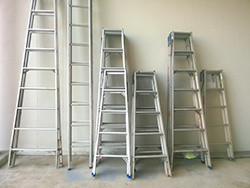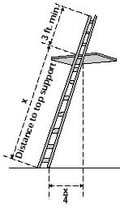 Both at work and at home, proper ladder selection, use, and maintenance are critical to your safety. Annually, ladder-related incident cause over 500,000 injuries and approximately 300 deaths. In the workplace, these injuries cost U.S. employers $11 billion annually. Lost work time, medical expenses, legal and liability costs, as well as pain and suffering.
Both at work and at home, proper ladder selection, use, and maintenance are critical to your safety. Annually, ladder-related incident cause over 500,000 injuries and approximately 300 deaths. In the workplace, these injuries cost U.S. employers $11 billion annually. Lost work time, medical expenses, legal and liability costs, as well as pain and suffering.
How can you prevent ladder-related falls? It starts by understanding what causes these incidents.
According to National Institute for Occupational Safety and Health (NIOSH), the top 5 causes of ladder falls at home and in the workplace are:
- Incorrect extension ladder setup angle
- Inappropriate ladder selection
- Insufficient ladder inspection
- Improper ladder use
- Lack of access to ladder safety tools and information
 Incorrect Extension Ladder Set-Up Angle
Incorrect Extension Ladder Set-Up Angle
If not set-up at the proper angle, a ladder can slide out at the base, causing falls and injuries. You should place the base a quarter of the working length of the ladder from the wall or vertical surface. Additionally, when accessing an elevated surface, straight or extension ladders should extend at least 3 feet above the point of support. This is illustrated on a diagram from OSHA.
Inappropriate Ladder Selection
Choosing the appropriate ladder for the task is important. Consider the type of ladder, load, material, and height.
Ladders come in 3 main types:
- Type I: Industrial. These are heavy-duty ladders with a load capacity of up to 250 pounds.
- Type II: Commercial. These are medium-duty ladders with a load capacity of up to 225 pounds often used for painting and related tasks.
- Type III: Household. These are light-duty ladders with a load capacity of up to 200 pounds.
You should calculate load by considering your weight in clothing plus the weight of any tools and materials you are carrying.
When choosing a ladder, you also need to take material into account. Although aluminum ladders are the most durable, as conductors they are unsuitable for use around electricity. Wood is a non-conductor but may rot if it gets wet. Fiberglass is the best option if you are looking for both durability and non-conductivity; however it is also the most expensive.
Next, think about height. On an extension ladder, you will have a reach of approximately 1 inch lower than length of the ladder. On a stepladder, expect a reach of around 4 feet above the stepladder’s height.
Insufficient Ladder Inspection
Conducting regular inspection and maintenance can help prevent falls. Consider the following tips:
- Regularly inspect ladders for breaks in the joints and latches.
- Check for cracks, broken welds, and rough spots in aluminum ladders.
- Look for cracked wood, splinters, and rotten or broken hardware in wood ladders. Never paint wood ladders as this can conceal cracks, rot, or other imperfections.
- Fiberglass ladders come coated in a layer of clear sealant. If you notice any damage, report it and do not use it.
Improper Ladder Use
Are you using ladders appropriately? Are you avoiding dangerous mistakes? Many ladder related-injuries can be avoided with proper use.
- Set up the ladder according to the included safety instructions and warnings.
- Wear shoes with non-slip soles.
- Before beginning to climb, align your body with the ladder, keeping your belt buckle between the rails, and firmly grip the rails with both hands.
- Face the ladder as you climb, moving one step at a time. Secure one foot before moving the other.
- If you are using a heavy ladder, ask another person to hold it while you are climbing or standing atop it.
- Whenever possible, use a line to haul up materials instead of carrying them up the extension ladder. If you need to carry something, take extra care to avoid losing your balance or tipping the ladder.
- Never use a ladder when you feel dizzy, tired, or otherwise unable to safely manage the task.
- Always open a stepladder fully before climbing, and use its front. The stepladder top is not a seat.
- Place the base of an extension ladder at a safe distance from the building or wall.
- Never go beyond the penultimate step on a stepladder or the fourth rung from the top on an extension ladder.
- Only one person may use a single-sided stepladder or extension ladder at a time.
- Always move the ladder to continue with a task rather than leaning to your side. Dismount before adjusting the ladder’s position.
Lack Of Access To Ladder Safety Tools And Information
Do you train your employers on ladder safety? Or at home, have you taken time to understand appropriate use and maintenance before working on a portable ladder? There are numerous resources available to help educate you or your employees, including:
- NIOSH Ladder Safety Mobile Application
- OSHA Portable Ladder Safety Quick Card
- OSHA: Safe Use Of Extension Ladders
- National Safety Council: Ladder Safety One Rung At A Time
- American Ladder Institute
Take time to learn proper ladder use and care in order to prevent ladder-related injuries at home and in the workplace.



